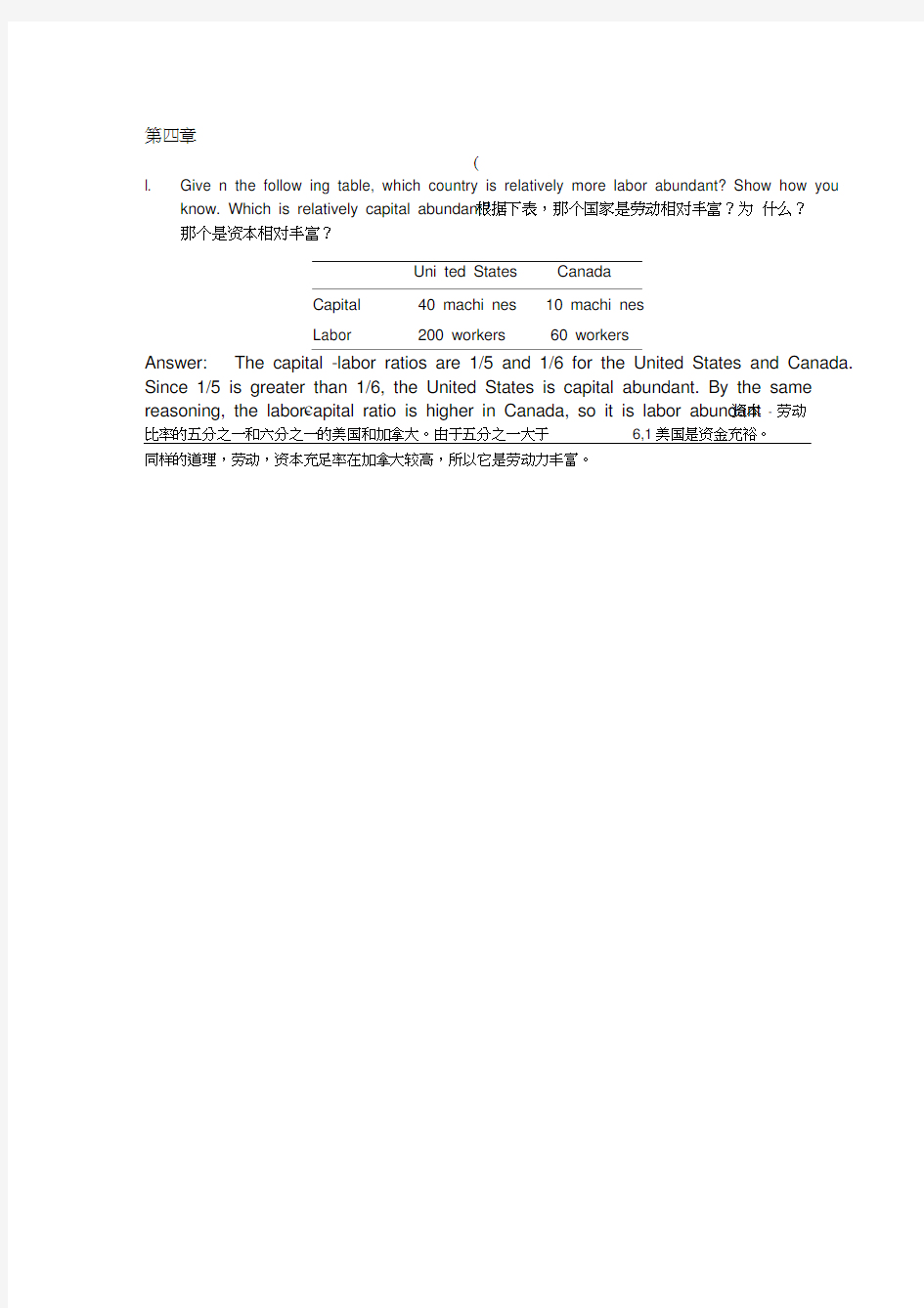国际经济学第五版第四章课后

- 1、下载文档前请自行甄别文档内容的完整性,平台不提供额外的编辑、内容补充、找答案等附加服务。
- 2、"仅部分预览"的文档,不可在线预览部分如存在完整性等问题,可反馈申请退款(可完整预览的文档不适用该条件!)。
- 3、如文档侵犯您的权益,请联系客服反馈,我们会尽快为您处理(人工客服工作时间:9:00-18:30)。
第四章
(
I. Give n the follow ing table, which country is relatively more labor abundant? Show how you
know. Which is relatively capital abundant?根据下表,那个国家是劳动相对丰富?为什么?
那个是资本相对丰富?
Uni ted States Canada
Capital 40 machi nes 10 machi nes
Labor 200 workers 60 workers
Answer: The capital -labor ratios are 1/5 and 1/6 for the United States and Canada. Since 1/5 is greater than 1/6, the United States is capital abundant. By the same reasoning, the labor-c apital ratio is higher in Canada, so it is labor abundant资本- 劳动比率的五分之一和六分之一的美国和加拿大。由于五分之一大于6,1美国是资金充裕。
同样的道理,劳动,资本充足率在加拿大较高,所以它是劳动力丰富。
2. Suppose that the United States and Canada have the factor endowments given in the
table in Question 1. Suppose further that the production requirements for a unit of steel is two machines and eight workers, and the requirement for a unit of bread is one machine and eight workers. 假设美国和加拿大在表中问题1 给出的要素禀赋进一步假设生产要求对钢铁的单位是两台机器和八名工人,和面包一个单位的要求是一台机器,八工人。
a. Which good, bread or steel, is relatively intensive in the use of capital? In labor? Show
how you know.
b. Which country would export bread? Why?
Answers:
a. The capital -abor ratio to make steel is 1/4; to make bread it is 1/8. Hence steel is
more capital intensive and bread is more labor intensive. 资本- 劳动比率,使钢的四分
之一; 做面包是八分之一。因此,钢铁是资本密集和面包是劳动密集型的。
b. Since the United States is capital abundant and steel is capital intensive, according to
the Heckscher-Ohlin trade model, the United States will export steel and Canada
will export bread. 由于美国是资本雄厚,钢铁是资本密集型的,根据赫克歇尔-
俄林贸易模式,美国将出口钢材和加拿大将出口面包。
3. Suppose that before trade takes place, the United States is at a point on its PPC where it
produces
20 bread and 20 steel. Once trade becomes possible, the price of a unit of steel is two units of
bread. In response, the United States moves along its PPC to a new point where it is
producing 30 steel and 10 bread. Is the country better off? How do you know? 假定在开放对外贸易前,美国在生产可能性曲线上表示20个单位面包和20 个单位钢铁的点上进行生产。一旦贸易进行,每单位的钢铁可以换 2 单位的面包。所以,美国将其生产点移至生产30单位钢铁和 1 0单位面包的地方。请问,美国的总生产情况有没有变得更好?为什么?
Answer: The United States is definitely better off because it can consume a greater quantity of both goods. If it traded five steel for 10 bread it would have 20
bread and 25 steel. This is the same amount of bread as before trade, and five
more units of steel. It can keep the extra five steel, or trade some or all of them
for additional bread. In either case, the consumption bundle is greater than it
was before trade. 美国无疑是更好,因为它可以消耗两种商品的数量更大。如果成
交 5 钢10 面包那就得20 面包和25 钢。这是面包如贸易前相同的量,及钢的五
个单位。它可以让多余的 5 钢或交易部分或全部的额外面包。在两种情况下,消费
束大于它交易之前。
4. Given the information in Questions 1 and 2, explain what happens to the returns to capital
and labor in each country after trade begins. 根据问题1 和问题2的信息,解释当贸易开始后资本和劳动力的投入回报率是怎样变化的。
